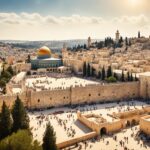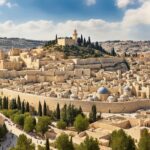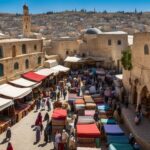Welcome to Bethlehem, the holy city that holds the distinction of being the birthplace of Jesus Christ. Located just 10 kilometers south of Jerusalem in the Holy Land, Bethlehem is a place of immense significance for Christians around the world. It is the site where Jesus was born over two thousand years ago, as documented in the Bible. The city’s historical and biblical importance has made it a popular destination for Christian pilgrims and those seeking to explore the roots of their faith.
Key Takeaways:
- Bethlehem is widely recognized as the birthplace of Jesus Christ.
- It is located 10 kilometers south of Jerusalem in the Holy Land.
- Bethlehem is a popular destination for Christian pilgrims and visitors to the Holy Land.
- The city holds immense religious and historical significance as the birthplace of Christ.
- Visiting Bethlehem offers a unique and profound experience for those interested in biblical sites and Christian pilgrimage.
History of Bethlehem
Bethlehem, a city with a rich and storied past, holds a significant place in history. According to biblical accounts, it is not only the birthplace of King David but also the revered location where Jesus was born. The historical timeline of Bethlehem is marked by remarkable events and influential figures that have shaped its identity over the centuries.
In the 4th century, Emperor Constantine the Great commissioned the construction of the original basilica at the site of Jesus’ birth. This basilica, which became a symbol of Christian devotion, stood as a testament to the region’s deeply rooted faith. Unfortunately, it faced destruction during the Samaritan revolts.
Emperor Justinian, in the 6th century, undertook a monumental task to rebuild the basilica in all its splendor. With his vision and resources, the basilica was restored to its former glory and became a beacon of Christian worship.
During the Crusader period, the basilica underwent further enhancements. The walls of the church were adorned with breathtaking wall paintings, and it became a coronation church for Crusader kings. These additions transformed the basilica into a magnificent pilgrimage site that captured the imaginations of believers.
Throughout history, Bethlehem also found itself under the rule of various Muslim dynasties, such as the Ayyubids and Mamluks. Despite the change in rulers, Bethlehem remained a place of spiritual importance and reverence, capturing the hearts of Christians around the world.
The Historical Timeline of Bethlehem:
| Period | Significant Events |
|---|---|
| 4th Century | Emperor Constantine the Great commissions the construction of the original basilica. |
| 6th Century | Emperor Justinian rebuilds the basilica after its destruction during the Samaritan revolts. |
| Crusader Period | The basilica is enhanced with wall paintings and becomes a coronation church for Crusader kings. |
| Ayyubid and Mamluk Periods | Bethlehem comes under the rule of various Muslim dynasties. |
The history of Bethlehem is a testament to the enduring significance of the city and its place in the hearts of believers. The stories of devotion, restoration, and unity continue to inspire and draw visitors from around the world to this sacred place.
Architecture of the Church of the Nativity
The Church of the Nativity showcases a remarkable blend of architectural styles spanning different historical periods. Its design is a testament to the craftsmanship and vision of several notable figures throughout history.
Originally commissioned by Constantine the Great in the 4th century, the basilica had an octagonal eastern end that encircles the revered cave believed to be the birthplace of Jesus. The structure also featured an ambulatory with side rooms, creating a sense of grandeur and sacredness.
During the reign of Justinian I in the 6th century, the church underwent further expansion and enhancement. Justinian I added a cruciform transept with three apses, elevating the architectural significance of the site.
However, it was the Crusader period that brought about significant renovations to the Church of the Nativity. Two bell towers were added, providing a distinctive visual element to the exterior. The interior was adorned with elaborate wall mosaics and paintings, enhancing the sacred atmosphere within the church.
Although some parts of the church have experienced damage and modifications over the centuries, the overall architectural character has been carefully preserved. Its enduring design serves as a testament to the historical and spiritual importance of the Church of the Nativity.
| Architectural Features | Period |
|---|---|
| Original basilica with octagonal eastern end and ambulatory | 4th century (Constantine the Great) |
| Cruciform transept with three apses | 6th century (Justinian I) |
| Bell towers and embellished interior with wall mosaics and paintings | Crusader period |

Importance of the Church of the Nativity
The Church of the Nativity holds immense significance for Christians around the world. It is revered as the birthplace of Jesus, making it a focal point of Christian pilgrimage. Every year, thousands of believers travel to Bethlehem to pay homage to Jesus and experience the sacredness of this historical site. Special services and ceremonies are held at the church during Christmas, attracting even larger numbers of pilgrims who gather to celebrate the birth of Christ.
The Nativity Grotto, located beneath the church, is a site of veneration where visitors can see the spot believed to be Jesus’ birthplace. This sacred space serves as a powerful reminder of the origins of Christianity and the importance of Bethlehem in the life of Jesus.
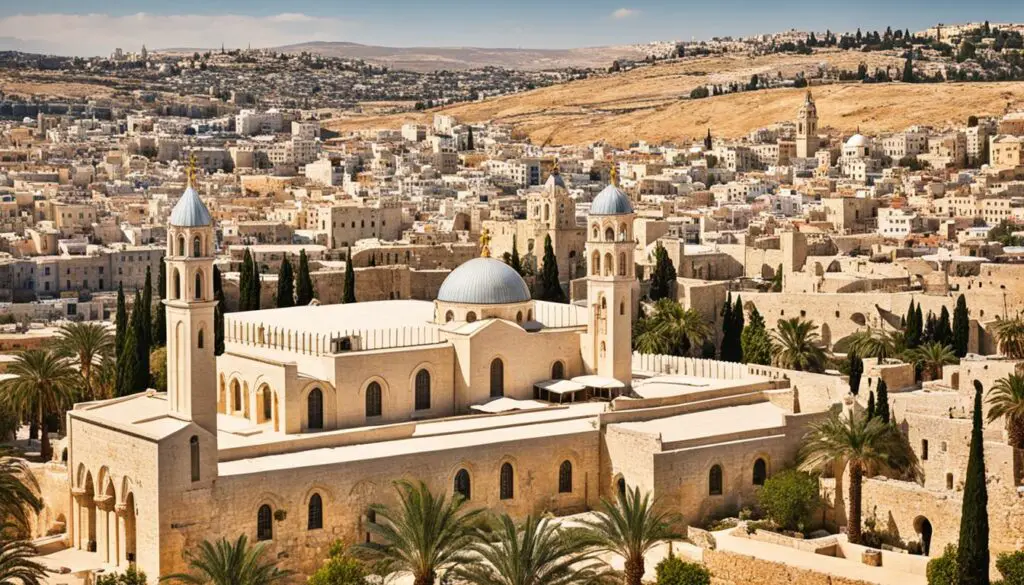
| Importance of the Church of the Nativity | Key Points |
|---|---|
| 1. Birthplace of Jesus | The church is believed to mark the exact spot where Jesus was born. |
| 2. Christian Pilgrimage | It is a significant destination for Christian pilgrims from around the world. |
| 3. Reverence and Worship | Special services and ceremonies are held, particularly during Christmas. |
| 4. Nativity Grotto | Visitors can witness and venerate the place of Jesus’ birth. |
Status Quo and Religious Cooperation
Since 1852, the Church of the Nativity has been governed by the Status Quo, an agreement that outlines the rights and responsibilities of the Catholic, Armenian Apostolic, and Greek Orthodox communities within the church.
The three denominations work together harmoniously to maintain the church and uphold their respective religious practices. This religious cooperation ensures that the Church of the Nativity remains a place of reverence and worship for Christians from around the world.
It is important to note that the Church of the Nativity also welcomes Muslim pilgrims, further exemplifying the interfaith cooperation and religious tolerance in Bethlehem. The ability for individuals of different faiths to visit and pay their respects at this holy site showcases the unity and shared devotion to spirituality experienced within the walls of the church.
Religious Cooperation at the Church of the Nativity
“Together, Catholics, Armenians, and Greek Orthodox Christians have worked diligently to preserve and maintain the Church of the Nativity, ensuring a sacred and inclusive space for all believers.” – Representative of the Church of the Nativity
| Denomination | Rights and Responsibilities |
|---|---|
| Catholic | Responsible for the altar of the Adoration and St. Catherine’s Church |
| Armenian Apostolic | Responsible for the Altar of the Nativity and St. Vartan’s Church |
| Greek Orthodox | Responsible for the Altar of the Crucifixion, the Katholikon, and St. Constantine’s Church |
The collaboration between these three major Christian denominations exemplifies the spirit of respect and unity in the pursuit of religious freedom and shared worship at the Church of the Nativity.
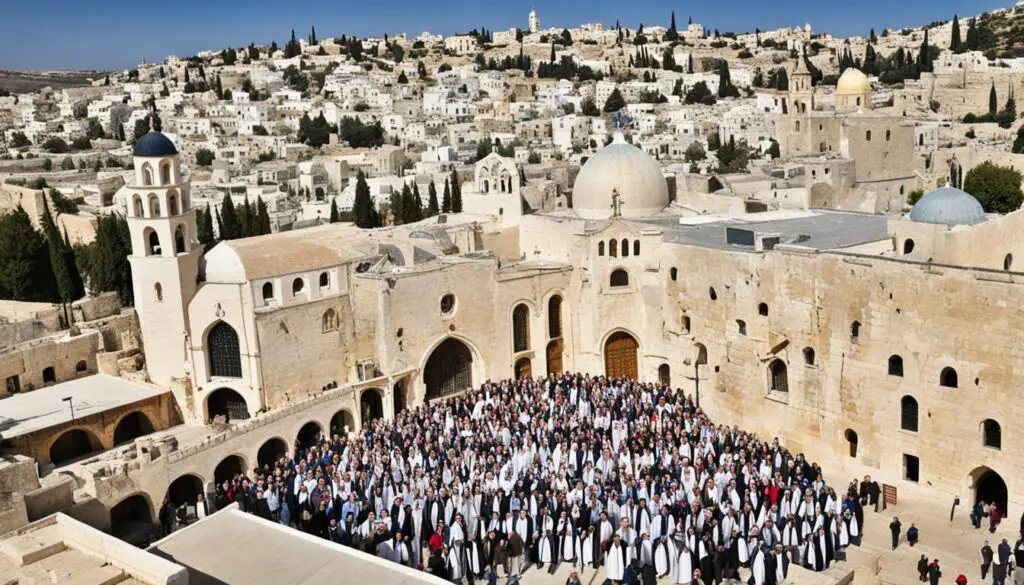
Image shows the Church of the Nativity, a testament to religious cooperation and unity.
Preservation and Restoration Efforts
Over the years, various preservation and restoration efforts have been undertaken to maintain the Church of the Nativity. The importance of preserving this historic site cannot be overstated, as it holds immense cultural and religious significance for Christians around the world. Recognizing its value, the Church of the Nativity was designated as a UNESCO World Heritage Site in 2012.
The preservation works have been aimed at conserving the original Byzantine and Crusader elements of the church, ensuring that future generations can appreciate its unique architectural and historical features. These efforts have involved addressing structural issues and repairing damage caused by the passage of time and conflicts.
To provide further insight into the rich history of the Church of the Nativity, the Terra Sancta Museum in Jerusalem has taken on the responsibility of preserving and displaying the church’s historical artifacts and treasures. This museum allows visitors to delve deeper into the fascinating story of the church and its role in the religious and cultural heritage of Bethlehem.
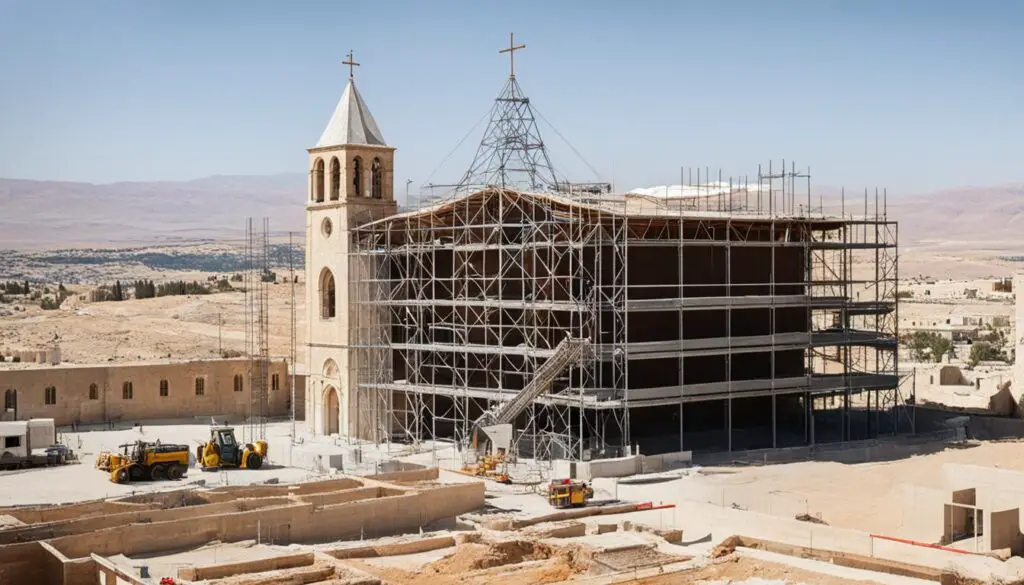
Christmas Celebrations in Bethlehem
Christmas in Bethlehem is a time of great celebration and religious significance. It is a special occasion that brings together pilgrims from around the world and local Christians to commemorate the birth of Jesus Christ. The highlight of the festivities is the Midnight Mass held at the iconic Church of the Nativity.
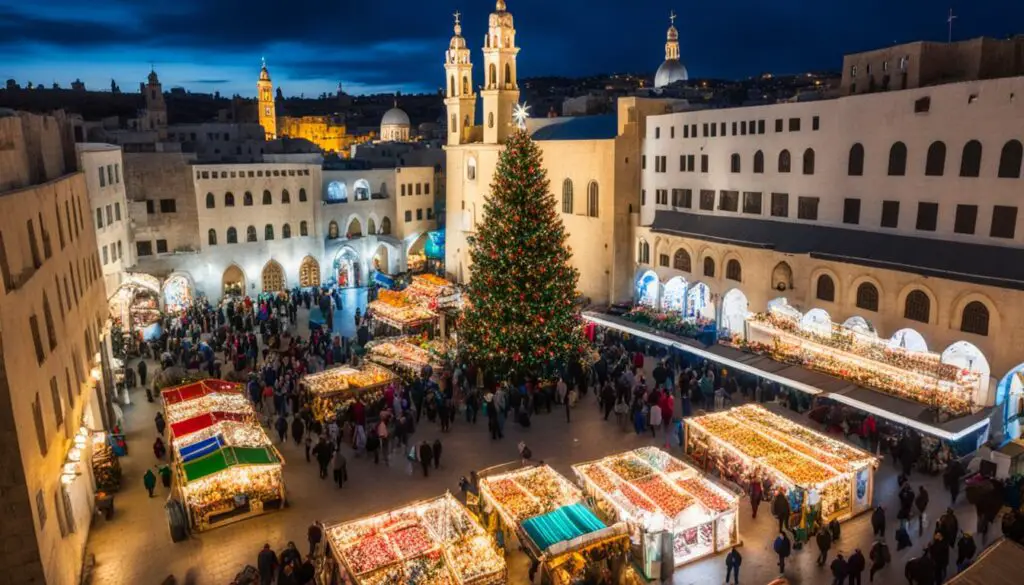
The Church of the Nativity, located in Manger Square, serves as the backdrop for the Midnight Mass, attracting thousands of worshippers each year. The Mass is a solemn and joyous occasion, where prayers and hymns fill the air, and the timeless story of Christ’s birth is retold. The atmosphere is incredibly immersive and evokes a profound sense of spirituality.
“Christmas waves a magic wand over this world, and behold, everything is softer and more beautiful.” – Norman Vincent Peale
Manger Square, surrounding the Church of the Nativity, is transformed into a festive space adorned with twinkling lights, colorful decorations, and a majestic Christmas tree. The tree lighting ceremony is a captivating moment, symbolizing the joy and hope of the holiday season.
“Christmas isn’t a season. It’s a feeling.” – Edna Ferber
The Franciscan Custody of the Holy Land, responsible for the care and administration of the Church of the Nativity, plays a significant role in organizing and facilitating the Christmas celebrations in Bethlehem. Their dedication and commitment ensure that visitors have an unforgettable experience as they witness the birthplace of Jesus Christ come alive with the spirit of Christmas.
Highlights of Christmas Celebrations in Bethlehem:
- Midnight Mass at the Church of the Nativity
- The lighting of the Christmas tree in Manger Square
- Festive decorations and vibrant atmosphere
- Pilgrims from around the world coming together to celebrate
- The profound spirituality and sense of reverence
Christmas in Bethlehem is a truly magical experience that allows pilgrims and visitors to connect with the birthplace of Jesus and immerse themselves in the rich religious heritage of the Holy Land.
Bethlehem as a Tourist Destination
Bethlehem is not only a place of religious significance but also a popular tourist destination. The city attracts visitors from around the world who come to explore its rich cultural and historical heritage.
One of the main attractions in Bethlehem is the iconic Church of the Nativity, known as the birthplace of Jesus. Pilgrims and tourists alike flock to this revered site to experience the profound spiritual atmosphere and pay homage to the Savior’s birth.
However, Bethlehem offers more than just the Church of the Nativity. Visitors can also explore other noteworthy sites like Rachel’s Tomb, a revered pilgrimage site for Jews, Muslims, and Christians; and the Shepherd’s Field, believed to be the place where the shepherds received the angels’ message about Jesus’ birth.
Immersing oneself in Bethlehem’s vibrant local culture is another highlight of the visit. Travelers can stroll through the bustling markets, sample traditional Palestinian cuisine, and engage with the warm and hospitable locals. The ancient streets of Bethlehem captivate with their charm and offer a glimpse into the city’s storied past.
To provide a visual reference for the diverse attractions in Bethlehem, here is a table highlighting some of the key sites:
| Attraction | Description |
|---|---|
| Church of the Nativity | The birthplace of Jesus Christ and a UNESCO World Heritage Site, attracting Christian pilgrims from around the world. |
| Rachel’s Tomb | A sacred burial place revered by Jews, Muslims, and Christians, believed to be the final resting place of the biblical matriarch Rachel. |
| Shepherd’s Field | Associated with the biblical account of the shepherds receiving the news of Jesus’ birth from the angels. |
| Bethlehem Old City | An enchanting maze of narrow streets, ancient buildings, and historical landmarks. |
| Bethlehem Museum | A cultural institution showcasing the rich heritage and history of Bethlehem and its people. |
With its blend of spirituality, history, and cultural experiences, Bethlehem offers a truly unique destination for tourists and Christian pilgrims alike.
Challenges and Constraints
Bethlehem, located in the occupied West Bank, faces numerous challenges and constraints due to political tensions and the Israeli occupation. These factors have a significant impact on the daily lives of the city’s residents and the overall development of Bethlehem as a tourist destination.
Restricted Movement and Livelihoods
One of the major challenges faced by Bethlehem is the presence of Israeli settlements, which surround the city and impose restrictions on Palestinian movement. These settlements limit the accessibility of Bethlehem and hinder the economic activities and livelihoods of its inhabitants. The limited mobility affects the local population’s ability to access education, healthcare, and employment opportunities, exacerbating socio-economic disparities in the region.
Israeli West Bank Barrier
The Israeli West Bank Barrier, a controversial structure built by Israel, further exacerbates the limited accessibility of Bethlehem. The barrier restricts the movement of Palestinians, separating them from their land, livelihoods, and essential services. The barrier also hampers the development of tourism in Bethlehem by deterring potential visitors and impeding the flow of goods and services.
Political Tensions and Conflicts
The political tensions and conflicts in the region have a significant impact on Bethlehem. They contribute to an uncertain and volatile environment, affecting the stability and growth of the city. The ongoing Israeli-Palestinian conflict and the broader geopolitical context in the Middle East create challenges for Bethlehem, both economically and socially.
Despite these challenges, Bethlehem continues to attract pilgrims and visitors who seek to experience the historic and religious significance of the city. The people of Bethlehem show resilience and determination in preserving their cultural heritage and promoting peace.
Bethlehem Beyond the Church of the Nativity
While the Church of the Nativity is the main draw for visitors to Bethlehem, the city offers much more to explore.
Travelers can discover the rich Palestinian heritage through visits to historical sites like the Old City and the Bethlehem Museum.
Art galleries, workshops, and souvenir shops offer opportunities to engage with Palestinian culture and support local artisans.
Bethlehem is also known for its traditional handicrafts, such as olive wood carvings and embroidery, which make for unique souvenirs and gifts.
Explore the cultural experiences and Palestinian heritage beyond the Church of the Nativity in Bethlehem. This table showcases some of the top attractions and handicrafts that make Bethlehem a fascinating destination for cultural exploration.
| Attraction | Description |
|---|---|
| Old City | Ancient streets filled with history and vibrant markets. |
| Bethlehem Museum | A treasure trove of artifacts and exhibitions showcasing the city’s history. |
| Art Galleries | Showcasing contemporary Palestinian artwork and fostering cultural exchange. |
| Workshops | Opportunities to learn traditional crafts such as pottery and ceramics. |
| Souvenir Shops | Support local artisans by purchasing unique handicrafts like olive wood carvings and embroidery. |
Immerse yourself in the beauty of Palestinian heritage and take home a piece of Bethlehem’s cultural legacy.
Bethlehem as a Symbol of Hope and Peace
Bethlehem, with its deep religious significance and history, has become a symbol of hope and peace. The city serves as a powerful reminder of the importance of interfaith dialogue and peaceful coexistence. Christians, Muslims, and other religious communities live side by side in Bethlehem, fostering a spirit of tolerance and understanding. The annual Christmas celebrations, attended by people from all over the world, demonstrate the universal desire for peace and goodwill.
Amidst the complexities of the Israeli-Palestinian conflict, Bethlehem stands as a beacon of hope for a future marked by harmony and collaboration. The city’s unique blend of cultures and faiths creates an environment where interfaith dialogue flourishes, enabling members of different religious communities to come together and engage in meaningful conversations.
The peaceful coexistence in Bethlehem is a testament to the power of embracing diversity and embracing the principles of empathy, respect, and understanding. It serves as a living example that people of various backgrounds and beliefs can coexist harmoniously and work towards common goals.
“In Bethlehem, we witness the beautiful tapestry of humanity, where people of different religious backgrounds join hands in celebration and reflection. It is a testament to the fact that peace is achievable, and dialogue is the path to understanding.” – Sheikh Mohammad Fatouh, Grand Imam of Al-Aqsa Mosque, Jerusalem
One of the most significant events that embodies the spirit of peace and hope in Bethlehem is the annual Christmas celebrations. The city comes alive with vibrant decorations, carol singing, and festive activities, attracting visitors from all corners of the globe. The Christmas tree lighting ceremony in Manger Square is a symbolic gesture, illuminating the desire for peace and unity.
In addition to the religious significance, Bethlehem’s rich cultural heritage contributes to its role as a symbol of hope and peace. The city’s ancient streets, traditional markets, and architectural marvels provide an immersive experience that showcases the resilience and vibrancy of the Palestinian people.
Interfaith Organizations in Bethlehem
| Organization | Mission |
|---|---|
| Bethlehem Interfaith Group | Promotes dialogue and understanding among Christians, Muslims, and Jews in Bethlehem |
| House of Prayer and Study | Facilitates interfaith activities and promotes peace through education and dialogue |
| Multaqa – The International Center for Shared Living | Creates spaces for interfaith dialogue and fosters peaceful coexistence in Bethlehem |
These organizations play a vital role in nurturing a culture of dialogue, cooperation, and peacebuilding in Bethlehem. Through their initiatives, they bring people from different backgrounds together, fostering mutual understanding and respect.
Bethlehem’s journey toward peace and reconciliation is an inspiration to the world. It reminds us that despite the challenges and conflicts that exist, there is always room for hope and unity. The city’s commitment to interfaith dialogue and peaceful coexistence serves as a guiding light in turbulent times, offering a blueprint for building bridges and fostering understanding among diverse communities.
Conclusion
Bethlehem, the birthplace of Jesus, holds immense religious and cultural significance for Christians worldwide. The Church of the Nativity stands as a testament to the historical and spiritual importance of the city. As a destination for Christian pilgrims and visitors to the Holy Land, Bethlehem offers a unique and profound experience of the birthplace of Jesus.
Despite the challenges and political tensions in the region, the city of Bethlehem continues to inspire hope and promote interfaith dialogue. Its rich cultural heritage, deeply rooted in the biblical narrative, attracts people from various backgrounds and beliefs who seek to connect with their faith and explore the origins of Christianity.
Visiting Bethlehem is not only a spiritual journey but also an opportunity to witness the peaceful coexistence of different religious communities. The city serves as a symbol of peace and unity, where Christians, Muslims, and others come together to celebrate and appreciate their shared humanity.
In conclusion, Bethlehem remains a place of pilgrimage and cultural significance, allowing visitors to connect with the birthplace of Jesus and experience the heritage of the Holy Land. It is a destination that embodies the universal values of faith, hope, and peace, transcending boundaries and bringing people closer to their spiritual roots.





